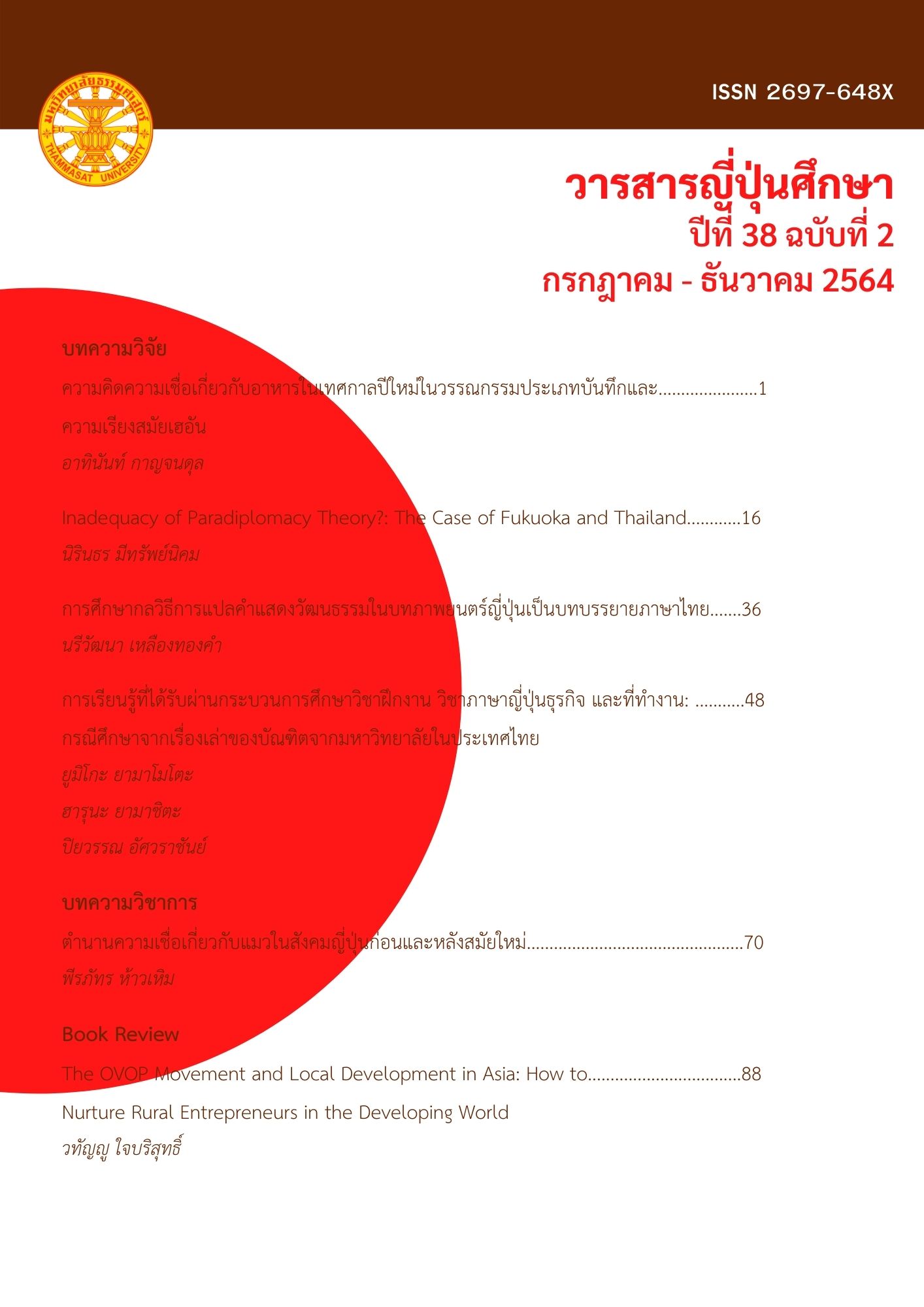Inadequacy of Paradiplomacy Theory?: The Case of Fukuoka and Thailand
Keywords:
Paradiplomacy, Inadequacy, Fukuoka, Thailand, Motives and GoalsAbstract
The explanatory framework of paradiplomacy emerged as a new field of research in the 1970s, which has subsequently evolved to explain the involvement of the sub-national governments’ engagement in international affairs. This paper aims to examine whether the theoretical model of paradiplomacy proposed by Alexander Kuznetsov (2015) is sufficient to analyse the Fukuoka Prefectural Government’s motives and goals in implementing activities in Thailand. This study employed qualitative approach and was based on secondary data. The findings demonstrate that Kuznetsov’s (2015) theoretical framework, which systematised existing paradiplomacy knowledge, is a valuable analytical lens. However, it is inadequate to guide a thorough inquiry of this issue. This paper identifies and bridges the gaps in theoretical development and model-building of paradiplomacy. New theories are still required to thoroughly investigate the rising trend of international relations at the local level.
Downloads
References
Accenture (2017, July 14). Accenture helps Fukuoka City establish a digitally enabled health model to help aging citizens stay healthy and live independently. https://tinyurl.com/2p9dfn2c
Bangkok Metropolitan Council. (2014). Practical collaboration on fire truck delivery projects (in Thai). https://tinyurl.com/bdusdxze
Bangkok Metropolitan Council. (2014). Agreement on the delivery of fire trucks between the Fukuoka Prefectural Council and the Bangkok Metropolitan Council (in Thai). https://tinyurl.com/4tkuywf6
Brinberg, D., & McGrath, J. E. (1985). Validity and the research process. Sage Publications. https://tinyurl.com/ycybvn33
Charprasert, R., (2015, December 9). Personal communication.
Fukuoka City (n.d.). Livable × business city: Fukuoka, National Strategic Special Zone for Global Startups and Job Creation. https://tinyurl.com/mthd84cu
Fukuoka Convention and Visitor Bureau (FCVB) (n.d.). Charms of Fukuoka City. https://tinyurl.com/bdfbv8ue
Fukuoka Prefectural Government, Bangkok Office. (n.d.). About Us. https://www.facebook.com/fukuoka.bkk
Fukuoka Prefectural Government, Bangkok Office (n.d.). Facebook page. https://tinyurl.com/5n6murv6
Fukuoka Prefectural Government. (n.d.). Creating a comfortable city for the elderly. https://tinyurl.com/yuh97y5c
Fukuoka Prefecture (n.d.). A guide to Fukuoka prefectural environment companies’ technologies (in Thai). https://tinyurl.com/2exxjtsh
Hak, T. and Dul, J. (2009). Theory-testing with cases. ERIM Report Series Reference, No. ERS-2009-037-ORG. https://ssrn.com/abstract=1433937
International Affairs Office (IAO), Bangkok Metropolitan Administration (BMA) (n.d.). Fukuoka Prefecture, Japan (in Thai). https://iao.bangkok.go.th/content-detail/12324
Im, Y., & Furutani T. (2015). Analysis of the policy network for tourism cooperation between Busan, Korea and Fukuoka, Japan. Urban and Regional Planning Review, 2, 1-19. https://doi.org/10.14398/urpr.2.1
Jain, P. (1992). Japan’s urban governments, their international activities and Australia-Japan relations: An exploratory essay. Policy, Organisation and Society, 4, 33-44, DOI: 10.1080/10349952.1991.11876767
Jain, P. (2004). Japan’s subnational governments in China: Emerging bilateral relations. Peace & Security, 16(1), 19-30. https://doi.org/10.1080/1478115042000176157
Jain, P. (2005). Japan’s subnational government in international affairs. Routledge.
Japan External Trade Organization (JETRO) (n.d.). Where to invest in Japan’s local regions, Fukuoka city. https://tinyurl.com/y6x9k2cm
Kuznetsov, A. (2015). Theory and practice of paradiplomacy: Subnational governments in international affairs. Routledge Taylor and Francis Group.
Memorandum of Understanding on Environmental Partnership Between Pollution Control Department, Ministry of Natural Resources and Environment, Thailand and the Fukuoka Prefectural Government, Japan. (2016, August 23). Pollution Control Department. https://tinyurl.com/yckvnp6n
Ministry of Foreign Affairs (MOFA), Thailand (2017, September 12). Chairman of Fukuoka Prefectural Assembly pays a courtesy call on the Minister of Foreign Affairs of the Kingdom of Thailand. https://tinyurl.com/2p88dj52
Ministry of Foreign Affairs (MOFA), Thailand (2018). H.E. Mr. Somkid Jatusripitak, Deputy Prime Minister of the Kingdom of Thailand, paid a visit to Fukuoka, Japan. https://tinyurl.com/4vkwbnp5
Mesupnikom, N. (2018). A new trend in local government relations: The case of Fukuoka and Bangkok, Veridian E-Journal, Silpakorn University (International Humanities, Social Sciences and Arts, 11(4), 1091-1108. https://tinyurl.com/ycxs8ku2
Nakamura, H., Elder, M. and Mori, H. (2011). The surprising role of local governments in international environmental cooperation. The Journal of Environment & Development, 20(3), 219-250. https://doi.org/10.1177/1070496511415644
Ogawa, A. (2012). Sister city as a preservation strategy [Master of Science in Historic Preservation], Graduate School of Architecture, Planning and Preservation Columbia University. https://tinyurl.com/2p8we94p
Pollution Control Department (PCD) (2018). Foreign operations and future directions of the Pollution Control Department (in Thai). https://tinyurl.com/92watun6
Prasirtsuk, K. et al. (2019). Thailand-Japan relations at the local level: Status and future possibility (in Thai). Thailand Research Fund.
Public Relations Office, Bangkok Metropolitan Administration (BMA) (2018). The Bangkok Metropolitan Council congratulated the Royal Thai Consulate in Fukuoka, Japan on its establishment (in Thai). https://tinyurl.com/2bbarbpj.
Public Relations Office, the Government of Japan. (2016). Fun and games in Fukuoka. https://tinyurl.com/yckhnp6c
Stake, R.E. (2000). The case study and generalizability. In R. Gomm, M. Hammersley, & P. Foster (Eds.), Case study method, key issues, key texts (pp. 19–26). Sage Publications.
Statista Research Department (2021). Number of inhabitants in Bangkok in Thailand from 2012 to 2021. https://tinyurl.com/4zs84bpc
Strategy and Evaluation Department, Bangkok Metropolitan Administration (BMA). (2018). Bangkok population and area statistics 2018 (in Thai). https://tinyurl.com/eensn262
Takao, Y. (2010). Reinvigorating the transnational links of sub-national governments between Australia and Japan with special reference to Western Australia-Hyogo sister-state relations. The Pacific Review, 23(4), 453-477. https://doi.org/10.1080/09512748.2010.496000
Thai PBS World. (2015, December 5). Bangkok ranks no. 2 of world’s top most visited cities. https://tinyurl.com/mt7dxwtn
Yin, R. K. (2014). Case study research design and methods. Sage Publication. DOI: 10.3138/cjpe.30.1.108
Downloads
Published
Issue
Section
License
Copyright (c) 2021 Japanese Studies Journal

This work is licensed under a Creative Commons Attribution-NonCommercial-NoDerivatives 4.0 International License.




